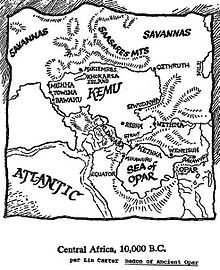Khokarsa
| Khokarsan Empire | |
|---|---|
 Map of Khokarsa and Opar | |
| Real-world | |
| Series |
Hadon of Ancient Opar, Flight to Opar |
| Creator | Philip José Farmer |
| Genre | Adventure novel, Prehistoric fiction |
| Fictional | |
| Capital | Khokarsa Island |
| Ethnic groups | Khoklem, Klemsuh |
| Government | Matriarchy |
| High Priestess of Kho | Awineth |
Khokarsa is a fictional empire in ancient Africa that serves as the primary setting for Philip José Farmer’s prehistoric fantasy novels Hadon of Ancient Opar, Flight to Opar, and The Song of Kwasin (the Khokarsa series).
Literary Origins
Farmer has stated that he derived Khokarsa from Ambrose Bierce's short story "An Inhabitant of Carcosa" (1891), in which the narrator's spirit visits an ancient fallen civilization. Over time, Farmer states, the syllables of the name "Khokarsa" were transposed so that the civilization eventually became known as "Carcosa."[1] An examination of Farmer's notes relating to the Khokarsa series has indicated that he also drew on classical sources to create his fictional civilization, such as Robert Graves' The White Goddess (which inspired the matriarchal basis of Khokarsan culture), Jessie L. Weston's classic Arthurian study From Ritual to Romance (whose "freeing of the waters" theme influenced Farmer's conception of the downfall of Khokarsan civilization), and the plays of Euripides (Farmer drew his depiction of the Khokarsan oracles directly from Euripides' description of the Oracle of Delphi).[2]
Fictional History
The origins of the Khokarsan civilization date back to 12,000 B.C., as the Khoklem people were expanding over the northern shore of the Kemu (the prehistoric northern inland sea of Central Africa). At this time, a man known as Sahhindar, the Gray-Eyed God, appeared in the region and came to be regarded by the locals as the god of plants, of bronze, and of Time, reputedly having been exiled from the land by his mother, the fertility goddess Kho, because he stole Time from her. Sahhindar appeared and reappeared among the Khoklem over a period of two thousand years, teaching them how to domesticate plants and animals, mine copper and tin, and make bronze tools, as well as teaching them the concept of zero. By circa 10,000 B.C. when the Khokarsa series begins, Sahhindar has brought the Khoklem from the Old Stone Age to the Bronze Age. “The Chronology of Khokarsa” addendum in Hadon of Ancient Opar hints that Sahhindar is actually John Gribardsun, the time-traveling protagonist from Farmer’s 1972 novel Time’s Last Gift,[3] one of Farmer's many characters based on Tarzan.
Geography and Culture
The empire of Khokarsa was centered around the shores of prehistoric Africa’s two great landlocked seas, the Kemu to the north in the Chad Basin and the Kemuwopar to the south in the Congo Basin. Around 13,000 B.C., a group of tribes called the Khoklem (the People of Kho) emigrated from the temperate savannas of what would later become the Sahara Desert after the end of the Ice Age, reaching the shores of the Kemu and pushing the Neanderthals and Neanderthal-human hybrids (the Klemqaba, or People of the Goat) to the south, and possibly assimilating some of them. Another group called the Klemsuh (the Yellow People) arrived in the area at approximately the same time. These peoples made livings fishing and hunting and gathering until the appearance of Sahhindar, the Gray-Eyed God, who taught them agriculture and advanced their culture dramatically. In 11,800 B.C., the hero Gahete of the Klemreskom, the People of the Fish-Eagle, was the first human to land on the island of Khokarsa in the northern Kemu. This island would eventually become the capital and hub of the great Khokarsan Empire. In the series, Opar is merely a mining outpost city in a much larger civilization created by Farmer.
By the time of Hadon of Ancient Opar and Flight to Opar, the Khoklem had settled the shores of both primordial inland seas and founded the expansive Bronze Age civilization of Khokarsa. The Khokarsans had a written syllabary, understood the principles of algebra, employed catapults and Greek fire, had an advanced navy of unireme, bireme, and trireme galleys, implemented a solar calendar, and established a samurai-like class of swordsmen called the numatenu who wielded iron broadswords.
The Khokarsan civilization was matriarchal, with the high priestess of Kho serving as queen and controlling everything in the society but military, naval, and engineering sectors, these latter being under the direct jurisdiction of the king, the high priest of the sun god Resu. At the opening of the Khokarsa series circa 10,000 B.C., a power struggle between the priestesses of Kho and the priests of Resu has been ongoing for over 800 years. This conflict erupts into civil war when King Minruth IV refuses to relinquish the throne to the hero Hadon, whose victory as champion of the Great Games of Klakor should bestow upon him the traditional right to marry the high priestess and assume the kingship. Because of Minruth’s play for power, the thirty queendoms of the empire are thrown into a state of bloody revolution as the priests attempt to assert their newfound authority over the priestesses.
See also
References
Citations
- ↑ Farmer, Philip José, "A Letter from Philip José Farmer" in Heritage of the Flaming God, Alan Hanson and Michael Winger, eds., Spokane, Washington: Waziri Publications, pages 87–88.
- ↑ Carey, Christopher Paul, "The Archaeology of Khokarsa" in Farmerphile: The Magazine of Philip José Farmer, no. 9, July 2007, Paul Spiteri, ed., pages 2–7.
- ↑ Farmer, Philip José, "Chronology of Khokarsa" in Hadon of Ancient Opar, New York, NY: DAW Books, page 205.